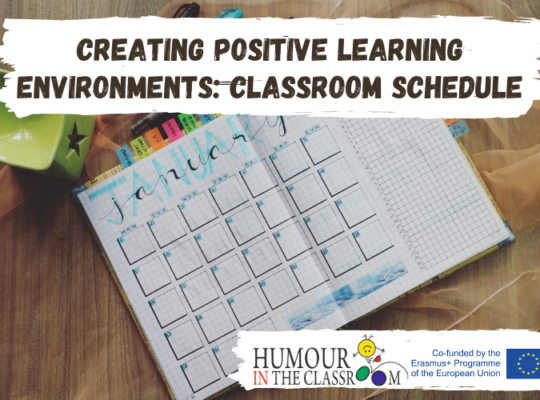Boredom may be the largest pedagogical obstacle to teaching (Smith, 2007), and many believe it is up to teachers to spark students’ interest in classes. One way to ignite students’ enthusiasm is by using humour. In the classroom, humour can create a cheerful learning climate, enhance social bonding through increased student-instructor interaction, add variety to lectures, decrease test anxiety, and provide enjoyment and laughter, (Bryant, Comisky, Crane, & Zillmann, 1980; Gorham & Christophel, 1990; Kaplan & Pascoe, 1977; Neumann, Hood, & Neumann, 2009; Schmitz, 2002).
In addition to the social benefits, humour is cognitively and pedagogically important. For instance, instructional humour has been touted as an excellent way for students to learn vocabulary, increase critical thinking, practice semantics, and remember more information (Bell, 2009; Dormann, & Biddle, 2006; Forsyth, 2003; Hill, 1988; Tatum, 1999; Ziv, 1988). Because humour often plays with meaning, it helps individuals change their current mental perspective by visualizing problems in an alternate way, as well as engaging their critical thinking (Dormann & Biddle, 2006; Wanzer, Frymier, & Irwin, 2009). For instance, it has been demonstrated that message relevant word puns increase vocabulary because students must first recognize an incongruity in the message and then resolve or interpret it (Tatum, 1999; Wanzer, Frymier, & Irwin, 2009). For example, “Does the name Pavlov ring a bell?” is a play on words that is related to a famous psychologist, but requires students to remember who Pavlov is and remember his work with conditioning in order to understand the humourous twist. Thus, recall, retention, and comprehension skills are practiced while decoding the pun.
It is generally believed that humour is beneficial and is often advised as a best practice by effective teachers. However, aside from anecdotal, little evidence exists of its benefits (e.g. Ruggieri, 1999; Tatum, 1999). Most of the very little empirical work that has been conducted addresses students’ and teachers’ preferences, satisfaction, and perceptions of effectiveness and learning (Gorham & Christophel, 1990; Ziv, 1988). A very small number of studies have examined the effect of humour on relevant cognitive outcomes or in the actual classroom and most of the research on humour in higher education takes place in laboratory settings (Gorham & Christophel, 1990; Kaplan & Pascoe, 1977; Ziv, 1988). While there are notable exceptions, the majority of empirical research on how humour affects cognitive outcomes examines memory after hearing a speech or lecture (see Ziv, 1988 for review). For example, Garner (2006) found that students who listened to pre-recorded statistics lectures containing humour remembered significantly more material than the students who heard the exact same lecture, from the same professor, without humour. While this is a great addition to the literature, it lacks ecological validity, in which the study methods actually represent the real-life environment. Listening to a pre-recorded lecture lacks the social interaction available in an actual classroom. Moreover, asking a student to pay attention for one hour, in a lab setting, is not the same as asking them to pay attention for three hours a week throughout an entire semester in a classroom setting.
In addition, most of the research which has examined cognitive outcomes assesses recall and recognition levels of learning, which equates to the lowest level of Bloom’s taxonomy of cognitive processing, the knowledge level (Bloom, Engelhart, Furst, Hill, & Krathwohl, 1956). At the knowledge level of learning, the skill that is required for mastery is basic memorization, not an in-depth grasp or understanding of the material (Bloom, et al., 1956; Granello, 2001; Lord & Baviskar, 2007). To date, no known studies have assessed humour’s effectiveness on Bloom’s slightly higher levels of learning. The second of Bloom’s levels, comprehension, denotes whether students have a basic understanding of the material (Granello, 2001; Lord & Baviskar, 2007). Comprehension assessments instruct students to translate, classify, or paraphrase information indicating an understanding of the intricacies of the material (Bloom, et al., 1956; Lord & Baviskar, 2007; Reid & McLoughlin, 2002). Bloom’s third level of learning, application, indicates whether students can connect, practice, or demonstrate learned information in a new situation or setting (Granello, 2001; Lord & Baviskar, 2007). Bloom’s taxonomy is organized in a hierarchical fashion, with higher levels of thought not mastered until one has achieved lower levels (Bloom, et al., 1956). However, this does not mean that understanding of a construct will always be strongest at the lower levels of Bloom’s taxonomy (e.g., knowledge). It is possible for one to have merely sufficient understanding of a construct at the knowledge level, but superior understanding of that same construct at higher levels of Bloom’s taxonomy (e.g., comprehension, application). For instance, a student may not recall the name of a phenomenon, indicating poor success at the knowledge level, but may still be able to comprehend and apply that construct. As the higher levels of Bloom’s taxonomy indicate more complex thought, it would be meaningful to evaluate humour’s effects on learning beyond the knowledge level.







What’s Taking place i am new to this, I stumbled upon this
I’ve discovered It absolutely helpful and it has aided
me out loads. I hope to give a contribution & assist different users
like its aided me. Great job.
This piece of writing gives clear idea for the new people
of blogging, that really how to do running
a blog.